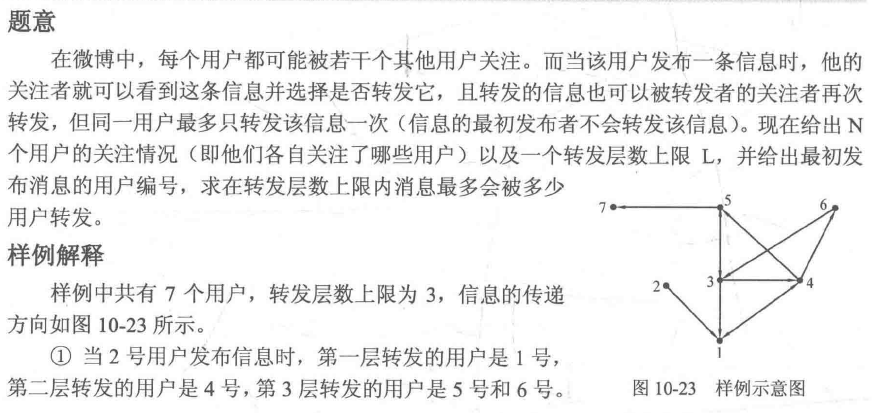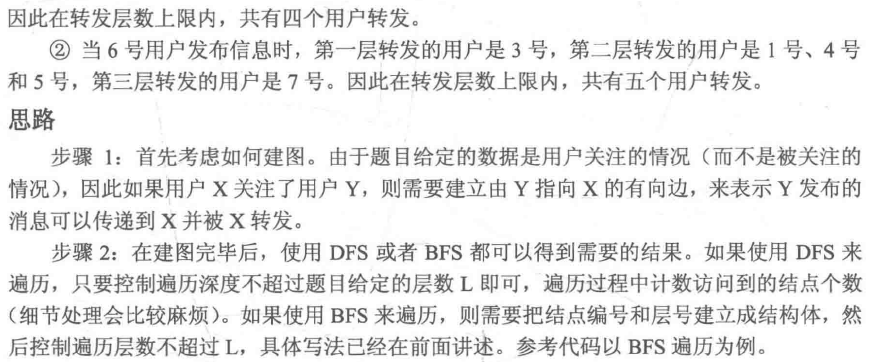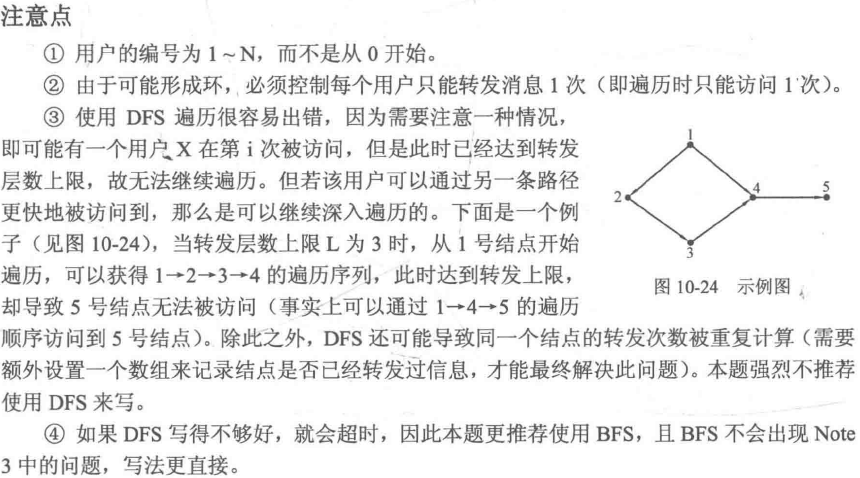1076. Forwards on Weibo (30)(图的遍历bfs)
Weibo is known as the Chinese version of Twitter. One user on Weibo may have many followers, and may follow many other users as well. Hence a social network is formed with followers relations. When a user makes a post on Weibo, all his/her followers can view and forward his/her post, which can then be forwarded again by their followers. Now given a social network, you are supposed to calculate the maximum potential amount of forwards for any specific user, assuming that only L levels of indirect followers are counted.
Input Specification:
Each input file contains one test case. For each case, the first line contains 2 positive integers: N (<=1000), the number of users; and L (<=6), the number of levels of indirect followers that are counted. Hence it is assumed that all the users are numbered from 1 to N. Then N lines follow, each in the format:
M[i] user_list[i]
where M[i] (<=100) is the total number of people that user[i] follows; and user_list[i] is a list of the M[i] users that are followed by user[i]. It is guaranteed that no one can follow oneself. All the numbers are separated by a space.
Then finally a positive K is given, followed by K UserID’s for query.
Output Specification:
For each UserID, you are supposed to print in one line the maximum potential amount of forwards this user can triger, assuming that everyone who can view the initial post will forward it once, and that only L levels of indirect followers are counted.
Sample Input:
7 3
3 2 3 4
0
2 5 6
2 3 1
2 3 4
1 4
1 5
2 2 6
Sample Output:
4
5
题目大意:
给出每个用户关注的人的id,和转发最多的层数,求一个id发了条微博最多会有多少个人转发
分析:
带层数的广度优先,因为一个用户只能转发一次,所以用inq判断当前结点是否入队过了,如果入队过了就不能重复入队(重复转发消息),inq 邻接表v 都可以使用int只存储id,queue的数据类型必须为node,同时保存它的id和layer层数,控制不超过L层~
原文链接:https://blog.csdn.net/liuchuo/article/details/52292939
题解



#include <bits/stdc++.h>
using namespace std;
const int MAXV=1010;
struct Node
{
int id,layer;
};
vector<Node> Adj[MAXV];
bool inq[MAXV];
int BFS(int s,int L)
{
int numForward=0;
queue<Node> q;
Node start;
start.id=s;
start.layer=0;
q.push(start);
inq[start.id]=true;
while(!q.empty()){
Node topNode=q.front();
q.pop();
int u=topNode.id;
for(int i=0;i<Adj[u].size();i++){
Node next=Adj[u][i];
next.layer=topNode.layer+1;
if(inq[next.id]==false&&next.layer<=L){
q.push(next);
inq[next.id]=true;
numForward++;
}
}
}
return numForward;
}
int main() {
Node user;
int n,L,numFollow,idFollow;
cin>>n>>L;
for(int i=1;i<=n;i++){
user.id=i;
cin>>numFollow;
for(int j=0;j<numFollow;j++){
cin>>idFollow;
Adj[idFollow].push_back(user);
}
}
int numQuery,s;
cin>>numQuery;
for(int i=0;i<numQuery;i++){
memset(inq,false,sizeof(inq));
cin>>s;
int numForward=BFS(s,L);
cout<<numForward<<endl;
}
return 0;
}
本文来自博客园,作者:勇往直前的力量,转载请注明原文链接:https://www.cnblogs.com/moonlight1999/p/15873373.html


 浙公网安备 33010602011771号
浙公网安备 33010602011771号